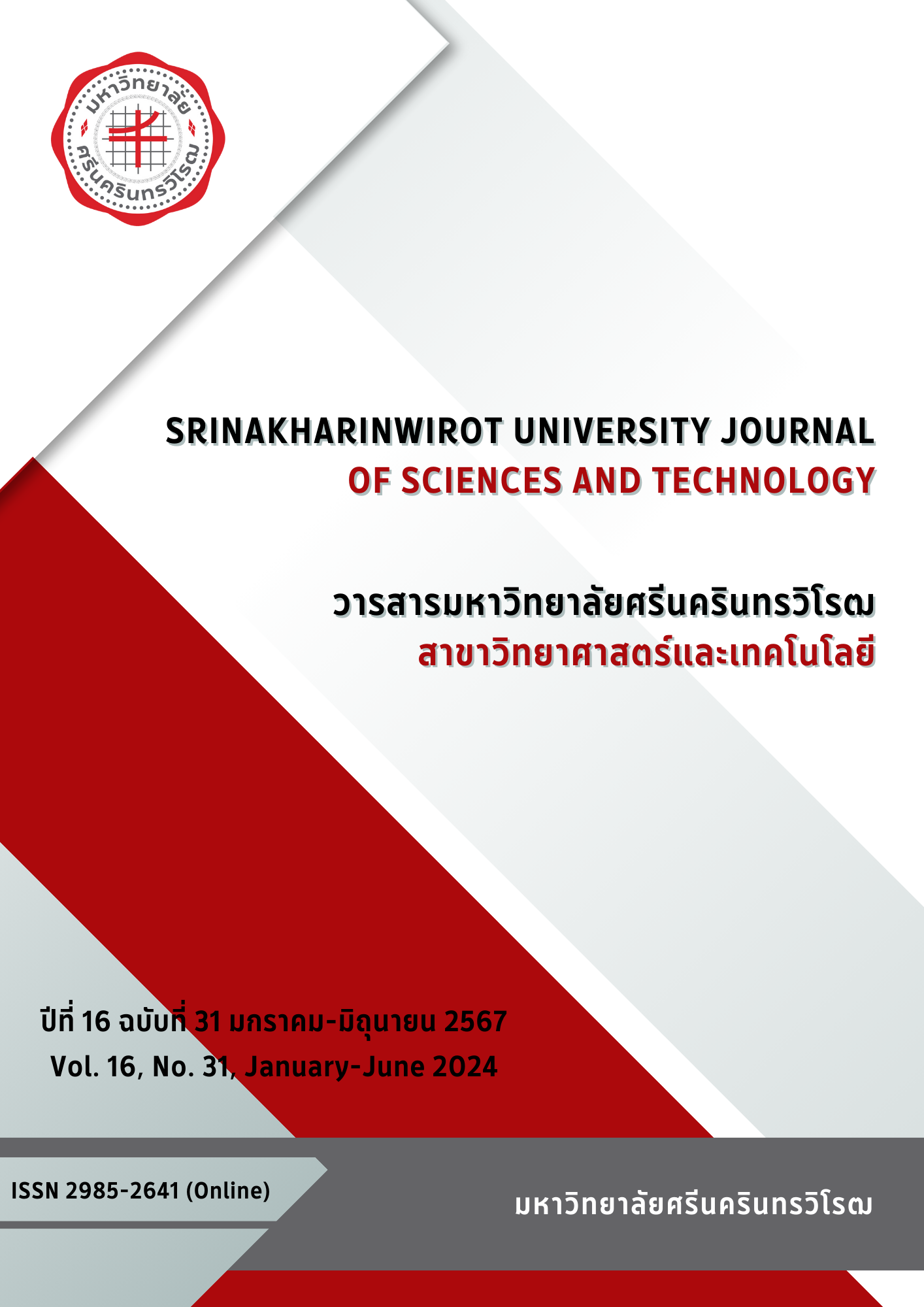ค่าความแข็งแรงของกล้ามเนื้อหายใจในคนไทย
คำสำคัญ:
กล้ามเนื้อหายใจ, แรงดันการหายใจเข้า, แรงดันการหายใจออก, ค่าอ้างอิงบทคัดย่อ
การวัดค่าความดันสูงสุดของการหายใจเข้า (maximal inspiratory pressure, MIP) และความดันสูงสุดของการหายใจออก (maximal expiratory pressure, MEP) เป็นการตรวจประเมินความแข็งแรงของกล้ามเนื้อหายใจเข้าและกล้ามเนื้อหายใจออก ซึ่งปัจจุบันยังไม่มีค่าปกติที่ใช้อ้างอิงสำหรับคนไทย การวิจัยครั้งนี้จึงมีวัตถุประสงค์เพื่อหาค่าปกติของ MIP และ MEP ในคนไทย และความสัมพันธ์ของ MIP และ MEP กับสัดส่วนร่างกาย โดยศึกษาในอาสาสมัครที่มีสุขภาพดี อายุ 20-60 ปี คำนวณกลุ่มตัวอย่างจากประชากรไทยด้วยสูตรของ Yamane ทำการสุ่มเลือกกลุ่มตัวอย่างแบบ conveniently sampling ได้จำนวน 405 คน (ชาย 167 คน และหญิง 238 คน) ทำการวัดค่าความดันโลหิต ส่วนสูง น้ำหนัก เปอร์เซ็นต์ไขมันในร่างกาย สมรรถภาพปอด และความแข็งแรงของกล้ามเนื้อหายใจเข้า และกล้ามเนื้อหายใจออก ผลการวิจัยพบว่า ค่าเฉลี่ย MIP และ MEP ในเพศชายเท่ากับ 105.4 เซนติเมตรน้ำ และ 134.2 เซนติเมตรน้ำ และเพศหญิงเท่ากับ 74.3 เซนติเมตรน้ำ และ 90.8 เซนติเมตรน้ำ ตามลำดับ เพศชายมีค่า MIP และ MEP มากกว่าเพศหญิงอย่างมีนัยสำคัญทางสถิติในทุกช่วงอายุ (p<0.001) ผลการศึกษาความสัมพันธ์ พบว่าค่า MIP มีความสัมพันธ์เชิงบวกกับส่วนสูง (r = 0.381, p<0.001) น้ำหนัก (r = 0.423, p<0.001) และดัชนีมวลกาย (r = 0.249, p<0.001) และมีความสัมพันธ์เชิงลบกับเปอร์เซ็นต์ไขมันในร่างกาย (r = - 0.229, p<0.001) ในส่วนของค่า MEP พบว่ามีความสัมพันธ์เชิงบวกกับส่วนสูง (r = 0.360, p<0.001) น้ำหนัก (r = 0.346, p<0.001) และดัชนีมวลกาย (r = 0.174, p<0.001) และมีความสัมพันธ์เชิงลบกับเปอร์เซ็นต์ไขมันในร่างกาย (r = - 0.262, p<0.001) โดยทั้งค่า MIP และ MEP ไม่มีความสัมพันธ์กับอายุ การศึกษาครั้งนี้สรุปได้ว่า ค่าปกติของความแข็งแรงของกล้ามเนื้อหายใจในคนไทยได้แสดงทั้งเพศชายและหญิง ความแข็งแรงของกล้ามเนื้อหายใจมีความสัมพันธ์เชิงบวกกับส่วนสูง น้ำหนัก ดัชนีมวลกายและมีความสัมพันธ์เชิงลบกับเปอร์เซ็นต์ไขมันในร่างกาย ส่วนอายุไม่มีความสัมพันธ์กับความแข็งแรงของกล้ามเนื้อหายใจ
Downloads
เอกสารอ้างอิง
Evans, J. A., and Whitelaw, W. A. (2009). The assessment of maximal respiratory mouth pressures in adults. Respiratory Care, 54(10), 1348-1359.
Sclauser Pessoa, I. M. B., Parreira, V. F., Fregonezi, G. A. F., Sheel, A. W., Chung, F., and Reid, W. D. (2014). Reference values for maximal inspiratory pressure: A systematic review. Canadian Respiratory Journal, 21(1), 43-50.
Wilson, S. H., Cooke, N. T., Edwards, R. H., and Spiro, S. G. (1984). Predicted normal values for maximal respiratory pressures in caucasian adults and children. Thorax, 39(7), 535-538.
Hautmann, H., Hefele, S., Schotten, K., and Huber, R. M. (2000). Maximal inspiratory mouth pressures (PIMAX) in healthy subjects--what is the lower limit of normal? Respiratory Medicine, 94(7), 689-693.
McConnell, A. K., and Copestake, A. J. (1999). Maximum static respiratory pressures in healthy elderly men and women: Issues of reproducibility and interpretation. Respiration, 66(3), 251-258.
Harik-Khan, R. I., Wise, R. A., and Fozard, J. L. (1998). Determinants of maximal inspiratory pressure the baltimore longitudinal study of aging. American Journal of Respiratory and Critical Care Medicine, 158(5 PART I), 1459-1464.
Neder, J. A., Andreoni, S., Lerario, M. C., and Nery, L. E. (1999). Reference values for lung function tests: II. Maximal respiratory pressures and voluntary ventilation. Brazilian Journal of Medical and Biological Research, 32, 719-727.
Simoes, R. P., Deus, A. P., Auad, M. A., Dionísio, J., Mazzonetto, M., and Borghi-Silva, A. (2010). Maximal respiratory pressure in healthy 20 to 89 year-old sedentary individuals of central Sao Paulo State. Revista Brasileira de Fisioterapia, 14(1), 60-67.
Johan, A., Chan, C. C., Chia, H. P., Chan, O. Y., and Wang, Y. T. (1997). Maximal respiratory pressures in adult Chinese, Malays and Indians. European Respiratory Journal, 10(12), 2825-2828.
Yamane, T. (1973). Statistics: An introductory analysis (3rd Ed). New York: Harper and Row.
Thoracic Society of Thailand under Royal Patronage. (2019). Guidelines for Pulmonary Function Test: Spirometry. Retrieved from https://thaichest.files.wordpress.com/2019/08/guidelinepft.pdf
Miller, M. R., Hankinson, J., Brusasco, V., Burgos, F., Casaburi, R., Coates, A., Crapo, R., Enright, P., van der Grinten, C. P. M., Gustafsson, P., Jensen, R., Johnson, D. C., MacIntyre, N., McKay, R., Navajas, D., Pedersen, O. F., Pellegrino, R., Viegi, G., and Wanger, J. (2005). Standardisation of spirometry. European Respiratory Journal, 26, 319-338.
American Thoracic Society/European Respiratory Society. (2002). ATS/ERS Statement on respiratory muscle testing. American Journal of Respiratory and Critical Care Medicine, 166(4), 518-624.
Nagano, A., Wakabayashi, H., Maeda, K., Kokura, Y., Miyazaki, S., Mori, T., and Fujiwara, D. (2021). Respiratory sarcopenia and sarcopenic respiratory disability: Concepts, diagnosis, and treatment. Journal of Nutrition, Health & Aging, 25(4), 507-515.
Woo, J., Arai, H., Ng, T. P., Sayer, A. A., Wong, M., Syddall, H., Yamada, M., Zeng, P., Wu, S., and Zhang, T. M. (2014). Ethnic and geographic variations in muscle mass, muscle strength and physical performance measures. European Geriatric Medicine, 5(3), 155-164.
Black, L. F., and Hyatt, R. E. (1969). Maximal respiratory pressures: Normal values and relationship to age and sex. The American Review of Respiratory Disease, 99(5), 696-702.
Janssen, I., Heymsfield, S. B., Wang, Z. M., and Ross, R. (2000). Skeletal muscle mass and distribution in 468 men and women aged 18-88 yr. Journal of Applied Physiology, 89(1), 81-88.
Chen, G., Liu, L., and Yu, J. (2012). A comparative study on strength between American College male and female students in Caucasian and Asian populations. Sport Science Review, 21(3-4), 153-165.
Cloutier, M. M. (2019). Respiratory physiology. Philadelphia: Elsevier.
Pazzianotto-Forti, E. M., Peixoto-Souza, F. S., Piconi-Mendes, C., Rasera-Junior, I., and Barbalho-Moulim, M. (2012). Behavior of respiratory muscle strength in morbidly obese women by using different predictive equations. Revista Brasileira de Fisioterapia, 16(6), 479-486.
ดาวน์โหลด
เผยแพร่แล้ว
รูปแบบการอ้างอิง
ฉบับ
ประเภทบทความ
สัญญาอนุญาต
ลิขสิทธิ์ (c) 2024 วารสารมหาวิทยาลัยศรีนครินทรวิโรฒ สาขาวิทยาศาสตร์และเทคโนโลยี

อนุญาตภายใต้เงื่อนไข Creative Commons Attribution-NonCommercial-NoDerivatives 4.0 International License.
วารสารมหาวิทยาลัยศรีนครินทรวิโรฒ สาขาวิทยาศาสตร์และเทคโนโลยี อยู่ภายใต้การอนุญาต Creative Commons Attribution-NonCommercial-NoDerivs 4.0 International (CC-BY-NC-ND 4.0) เว้นแต่จะระบุไว้เป็นอย่างอื่น โปรดอ่านหน้านโยบายของวารสารสำหรับข้อมูลเพิ่มเติมเกี่ยวกับการเข้าถึงแบบเปิด ลิขสิทธิ์ และการอนุญาต



